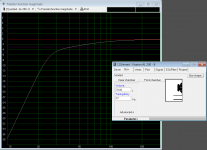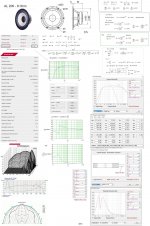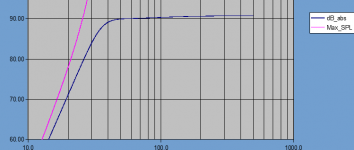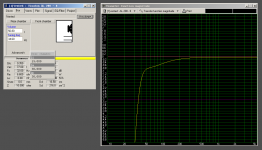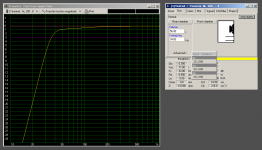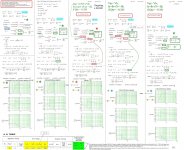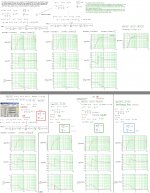Hello, all
I am cudgeling my brains about Visaton's official enclosure recommendations for their 8 Ohm AL 200 woofer with a Vas of 77 litres, a Qts of 0.35, and an Fs of 32 Hz.
Specifically, the last option with Vb = 70 l. and Fb = 27 Hz does not model well. Am I missing something or do you think it is an error on their site?
I am cudgeling my brains about Visaton's official enclosure recommendations for their 8 Ohm AL 200 woofer with a Vas of 77 litres, a Qts of 0.35, and an Fs of 32 Hz.
Specifically, the last option with Vb = 70 l. and Fb = 27 Hz does not model well. Am I missing something or do you think it is an error on their site?
Seems OK to me. It is larger and lower tuned than what gives a flat response, which results in a shallow roll off between 100 and 30 Hz. Some people say this mixes better with room gain, as deep bass is often excessively boosted by the room. Furthermore, do not forget the series resistance of the inductor if you will be using a passive crossover. This will make the response flatter.
Attachments
Last edited:
Thank you, TBTL, I am getting the same result in WinISD (should have attached the driver's .wpr file for your conveniece). I had not thought of room gain. In my room, whose only treatment consists of soft furniture and carpets, the mid-bass region is gone wild, but the steady room gain is not present. Do you know whether any HiFi or High End manufacturers deliberately tune their loudspeaker systems to be that far from the flat frequency response in the anechoric chamber? I don't think they do, do they?
As to the inductance, yes, I am going to have a low-pass filter, but near Fb its resistance will be negligible.
As to the inductance, yes, I am going to have a low-pass filter, but near Fb its resistance will be negligible.
The variation between rooms tends to be huge 🙁 No I have no idea how higher end loudspeakers are tuned. The lower end is usually tuned for boomy bass to impress customers.In my room, whose only treatment consists of soft furniture and carpets, the mid-bass region is gone wild, but the steady room gain is not present. Do you know whether any HiFi or High End manufacturers deliberately tune their loudspeaker systems to be that far from the flat frequency response in the anechoric chamber? I don't think they do, do they?
Thank you very much for the calculations, bjorno. I do not think your formula for B4 agrees with D.B. Keele, according to whom (and to Thiele) Vb = 0.707*Vas for Qt = 0.383, while your formula in that case gives Vas = 73.51. Consequently, your recommended Vas = 58 l. and fb = 35 Hz do not yield a (more or less) flat response in WinIsd, even if I remove all losses from the model. Am a missing something?
What do you mean? Vas is a fixed T/S parameter 77 liters for the driver. What do you mean with recommended Vas? Do you mean recommended alignment Vb@Fb ?! A recommended (between thousands) alignment is a net volume Vb and tuning Fb. Have fun.Thank you very much for the calculations, bjorno. I do not think your formula for B4 agrees with D.B. Keele, according to whom (and to Thiele) Vb = 0.707*Vas for Qt = 0.383, while your formula in that case gives Vas = 73.51. Consequently, your recommended Vas = 58 l. and fb = 35 Hz do not yield a (more or less) flat response in WinIsd, even if I remove all losses from the model. Am a missing something?
Yes, I meant Vb but made a typo.What do you mean? Vas is a fixed T/S parameter 77 liters for the driver. What do you mean with recommended Vas? Do you mean recommended alignment Vb@Fb ?! A recommended (between thousands) alignment is a net volume Vb and tuning Fb. Have fun.
Thank you very much for the calculations, bjorno. I do not think your formula for B4 agrees with D.B. Keele, according to whom (and to Thiele) Vb = 0.707*Vas for Qt = 0.383, while your formula in that case gives Vas = 73.51. Consequently, your recommended Vas = 58 l. and fb = 35 Hz do not yield a (more or less) flat response in WinIsd, even if I remove all losses from the model. Am a missing something?
All of Thiele's alignments from the 1961/'71 paper are for the lossless condition (academically interesting) and do not apply in real life.
B4 is only Vas/sqrt(2) for the lossless condition; for lossy boxes, Vb and Qts get bigger. For Ql=7, B4 is actually 1.05*Vas and Qts=0.4048.
Keele's formula is actually a curve fit of QB3 and C4 at Ql=7, curves which meet at B4. For the model bjorno is using (leakage+port+box damping) the usual alignments can't technically even be calculated because there are too many terms in the characteristic equation...
As TBTL said they do the same with the HF. In a form fashion of a catenary type, meaning both ends LF and HF are increased. Usually the highs are hot and the speaker is bad tuned with a high Q factor and low damping (commercial more not in the audiophile versions.)...No I have no idea how higher end loudspeakers are tuned. The lower end is usually tuned for boomy bass to impress customers.
I think he wrote that in well-made cabinets the losses were low enough for his lossless model to hold correct.All of Thiele's alignments from the 1961/'71 paper are for the lossless condition (academically interesting) and do not apply in real life.
A very large effect, and very different from WinISD, which assumes Ql=10 by default. I still can't get WinISD to model bjorno's suggested alignment to be flat, even by modifying the losses...B4 is only Vas/sqrt(2) for the lossless condition; for lossy boxes, Vb and Qts get bigger. For Ql=7, B4 is actually 1.05*Vas and Qts=0.4048.
I think he wrote that in well-made cabinets the losses were low enough for his lossless model to hold correct.
He didn't really state things as such. In his figures he even ignores leakage loss, which is probably more significant than enclosure or port losses. Then he did some hand-waving to justify the mathematical expediency of neglecting enclosure and port losses.
With your woofer, the Small-Margolis curve fit suggests
Vb=48.2L
Fb=36.8Hz
Keele's formula suggests
56.8L
34.6Hz
You are, of course, free to adjust those values to whatever gives you a response shape that "models well", whatever that means. If you don't like the drooping response of a 70L/27Hz box go higher tuning and/or smaller box.
Keele's alignment looks like this, FWIW (sim neglects inductance, but uses Qa=Qp=30 and Ql=15)
Attachments
Last edited:
I have decided on a model box with a Vb of 60 l. and an Fb of 34.5 Hz. According to WinISD, with an added series resistance of 0.5 Ohm, Qa = Qp = 100 and Ql = 10 it has a nearly flat FR with an F-3 of 34.5 Hz. I will play with this box to see which suggestion is the closest, decreasing the volume if required.With your woofer, the Small-Margolis curve fit suggests
Vb=48.2L
Fb=36.8Hz
Keele's formula suggests
56.8L
34.6Hz
You are, of course, free to adjust those values to whatever gives you a response shape that "models well", whatever that means. If you don't like the drooping response of a 70L/27Hz box go higher tuning and/or smaller box.
Here's what I get for it in WinISD without inductance:Keele's alignment looks like this, FWIW (sim neglects inductance, but uses Qa=Qp=30 and Ql=15)
Attachments
If not measured, why aren't you designing using its published 1.2 mH inductance [Le]? Also, why aren't you using the more advanced, accurate V0.7 WinISD?
https://www.facebook.com/WinISD/posts/126113234166443
GM
https://www.facebook.com/WinISD/posts/126113234166443
GM
I wanted my graphs to be comparable with Ron's. Le does not seem to affect the optimal tuning of the box, although it does affect the overall frequency response.If not measured, why aren't you designing using its published 1.2 mH inductance [Le]?
What is more advanced about it, and why do you think it is more accurate? If it is then I will switch to it. v. 0.50a7 evinced very good correspondence to the measurements of my existing vented and closed loudspeakers, so I trust it.Also, why aren't you using the more advanced, accurate V0.7 WinISD?
https://www.facebook.com/WinISD/posts/126113234166443
Last edited:
WinISD is a Program that is only correct at solely one Point at a time in any of the possible FR graphs. Thus: Referring to the flatness of a WinISD FR graph that in reality never making any true sense at all is only an 'flawed eye candy', thus always revealing a Layman that is arguing poorly.
Thank you, bjorno. What do you mean by "one point at a time"? That WinISD FR graphs are correct at only one (frequency, magnitude) point? Why does is happen? Does WinISD use so sorely flawed a model?
- Status
- Not open for further replies.
- Home
- Loudspeakers
- Subwoofers
- Recommended enclosure for Visaton AL 200 8 Ohm
